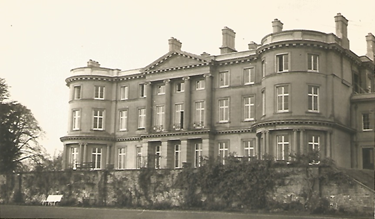Growing up in Llanarth
Growing up in Llanarth
by Peter Nash
Llanarth
Court: Photograph taken by Peter’s parents
I was brought up in the
village of Llanarth, half way though the last century. My parents had come to
the village in 1949, to take up jobs as teachers in Llanarth Court in the
recently opened boys’ preparatory school, Blackfriars, run by Dominicans. I was
born 10 months after their arrival and my mother stopped work. We lived in the
Pitt House, a 17th Century farmhouse with a priest’s hole in the
central chimney: Llanarth was and always had been a Catholic village.
In 1953 mum then got a
job in the village school, Clytha RC, but known to everyone locally as the Pitt
School. It had two teachers, upstairs for juniors, where Eileen Badham, ruled
with a rod of iron, and downstairs for Infants, where my mum held sway. There
were about 40 pupils at this time. I started school, before my fourth birthday,
as a dispensation for my mother. I soon learned that the
highlight of the school year was the Christmas party. Late in the autumn term
our teachers would walk us along the lane to the village hall, with its laid up
trestle tables and dance floor. Miss Badham would have us playing games. The
climax was “Farmer’s in his den”, and when we had finished beating the “dog”,
Father Christmas would arrive on the back of a grey “Fergie” tractor. He would
give us each a present. In those days presents were few; I remember being given
a toy woodworking kit. Then we would devour a tea of sandwiches and jelly.
We scarcely noticed the two coated adults who sat at the side of the hall. The gentleman was rather short and slightly rotund with a twinkle in his eye, the lady straight backed, taller and more austere. She was the Hon. Fflorens Roch, the only surviving child of Lord Treowen and last of the direct line of Jones/Herberts the owner of the Llanarth, Treowen, Llanover and Penllyn estates. He was Walter “Wattie” Roch, her husband a former MP for Pembrokeshire. They owned the village and most of the houses we lived in. Fflorens’ great grandfather, John Jones, had built our school in 1848. Every year she paid for a party and the presents, although the villagers made a contribution from the proceeds of a Whist Drive. She had built the Village Hall and had given the land for the cricket pitch next to it and she had given her house, the Court, to the Dominicans.
When I was seven, I left
the Pitt School. The Dominicans had offered me an education at Blackfriars. I
got to know the interior of Fflorens’ old house well. The Court still contained
many beautiful paintings and had an amazing library with a ceiling painted by
an Italian artist the previous century. There was the beautiful Treowen oak
screen dating back to the 1620s with racks of old weapons. Near the front door
hung Lord Treowen’s swords, one he used in the Mahdi campaigns in the Sudan in
the 1880s below which was his baton as commander of the Canadian Militia. In
the staff room was a portrait of Fflorens’ brother Elidyr who was killed at the
Battle of Huj in November 1917. The place was full of history.
We had Mass every day in
the chapel which, dating from 1750, is the oldest Catholic chapel in Wales and
Fflorens would walk there daily on her own path through the trees. Her two corgis
would sit with her at the back of the church. When she was away the dogs would
come without her. Wattie died in 1965 aged 85 and Fflorens four years later. In
1971, I played Father Christmas at the school party. In 1985 the Pitt School
closed.
In later years I found
that Wattie’s parliamentary career, although it lasted only 10 years, was
glittering. He had been tipped as a
possible Prime Minister but his loyalty to Asquith proved his downfall. Indeed
his scrupulous honesty made him outspoken. He sat as the Welsh representative
on the 1st Dardanelles Commission and, along with former Prime
Ministers of Australia and New Zealand, he refused to sign off the findings. A
barrister by profession, he surgically criticised the report in a separate
memorandum.
Last week a friend sent
me a cutting about Wattie from the Times
in 1965 describing him as a fine talker, wit and centre of a group, including H. G.
Wells and Arnold Bennet, who met at the Reform Club in the 1920s and 30s; that
he had played cricket for Harrow and once raced in the Grand National. In the
words of the writer of the article, the author Frank Swinnerton, he was “a very
remarkable man” and Fflorens was a very remarkable person too.
 |
| This plaque is in the chapel at Llanarth behind the pew in which Fflorens always sat. click below to see more information |


